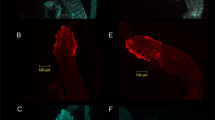Abstract
IN the isolated frog skin, it was found by Zerahn1 and by Leaf and Renshaw2 that the amount of sodium actively transported had a fixed relationship to the net oxygen consumption (sodium/net oxygen ratio), as about 18 sodium ions were transported per molecule of oxygen consumed under a variety of experimental conditions. Net oxygen consumption was defined as the difference between the total oxygen uptake and the basal uptake, that is, the oxygen uptake when no sodium transport took place. In the mammalian kidney, active re-absorption of sodium (anions and water following passively) represents on a molar basis the overwhelming part of all tubular transport processes. On the assumption that sodium re-absorption does therefore require the bulk of the oxidative energy supplied, we have determined the sodium/net oxygen ratio in the intact kidney of the dog.
This is a preview of subscription content, access via your institution
Access options
Subscribe to this journal
Receive 51 print issues and online access
$199.00 per year
only $3.90 per issue
Buy this article
- Purchase on Springer Link
- Instant access to full article PDF
Prices may be subject to local taxes which are calculated during checkout
Similar content being viewed by others
References
Zerahn, K., Nature, 177, 937 (1956); Acta Physiol. Scand., 36, 300 (1956).
Leaf, A., and Renshaw, A., Nature, 178, 156 (1957).
Van Slyke, D. D., and Neill, J. M., J. Biol. Chem., 61, 523 (1924).
Barcroft, J., The Respiratory Function of the Blood (Cambridge, 1914). Terroux, K. G., Sekelj, P., and Burgen, A. S. V., Canad. J. Biochem. Physiol., 37, 5 (1958).
Ohara, K., Jap. J. Physiol., 2, 11 (1951).
Still, E. U., Bennett, A. L., and Scott, V. B., Amer. J. Physiol., 106, 509 (1933).
Merrill, A. J., J. Clin. Invest., 25, 389 (1946).
Barker, H. G., Clark, J. K., Crosley, jun., A. P., and Cummins, A. J., Amer. J. Med. Sci., 218, 715 (1949).
Clark, J. K., and Barker, H. G., J. Clin. Invest., 30, 745 (1951). Bucht, H., Werkö, L., and Josephson, B., Scand. J. Clin. and Lab. Invest., 1, 277 (1949). Van Slyke, D. D., Rhoads, C. P., Hiller, A., and Alving, A. S., Amer. J. Physiol., 109, 336 (1934).
Rhorer, L. v., Pflüg. Arch. ges. Physiol., 109, 375 (1905).
Author information
Authors and Affiliations
Rights and permissions
About this article
Cite this article
THAYSEN, J., LASSEN, N. & MUNCK, O. Sodium Transport and Oxygen Consumption in the Mammalian Kidney. Nature 190, 919–921 (1961). https://doi.org/10.1038/190919a0
Issue Date:
DOI: https://doi.org/10.1038/190919a0
This article is cited by
-
Implications of microRNA in kidney metabolic disorders
ExRNA (2020)
-
Mitochondrial dysfunction in diabetic kidney disease
Nature Reviews Nephrology (2018)
-
Restoration of kidney function after prolonged renal artery occlusion
Pediatric Nephrology (1990)
-
Trimethaphan-induced hypotension: effect on renal function
Canadian Anaesthetists’ Society Journal (1982)
-
Effect of hypothermia on renal sodium reabsorption
Pfl�gers Archiv European Journal of Physiology (1973)
Comments
By submitting a comment you agree to abide by our Terms and Community Guidelines. If you find something abusive or that does not comply with our terms or guidelines please flag it as inappropriate.



